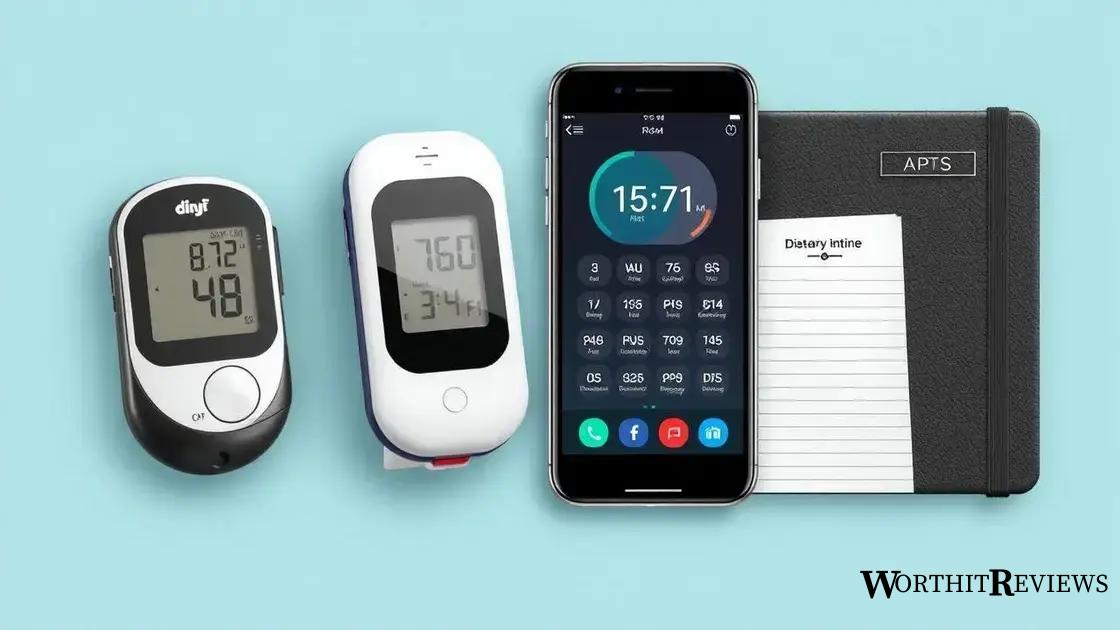Diabetic sugar readings are essential for managing diabetes effectively, as they help individuals monitor blood glucose levels, make informed dietary and medication choices, and prevent complications.
Diabetic sugar readings play a vital role in managing diabetes and maintaining overall health. Have you ever wondered how these readings can impact your daily life? Let’s explore their significance together.
What are diabetic sugar readings?
Diabetic sugar readings refer to the measurements of glucose levels in the blood. These readings are vital for individuals managing diabetes as they indicate how well the body is controlling blood sugar. Regular monitoring helps in making informed decisions about diet, activity, and medication.
Typically, readings are taken using a device called a glucometer, which provides quick results. It is important to know whether you are checking fasting blood sugar or post-meal levels, as these can vary significantly.
Types of Diabetic Sugar Readings
There are two primary types of readings: fasting blood sugar and postprandial blood sugar. Fasting blood sugar is taken after not eating for at least 8 hours, while postprandial levels are checked 1-2 hours after eating.
Importance of Accurate Readings
Accurate readings are crucial for effective diabetes management. They help in determining how the body responds to food, exercise, and medications. Maintaining blood sugar within the target range can prevent complications and promote overall health.
Interpreting the Readings
Understanding what the numbers mean is essential. A normal fasting level is usually between 70-100 mg/dL, while post-meal levels should ideally be below 180 mg/dL. Values outside these ranges can indicate issues that need attention.
Why accurate readings matter for diabetics

Accurate readings play a crucial role for diabetics in managing their condition effectively. With the right data, individuals can make informed decisions about diet, exercise, and medication. This can help avoid severe highs or lows in blood sugar levels.
Preventing Complications: Consistent monitoring and accurate readings can prevent long-term complications associated with diabetes, such as heart disease, nerve damage, and kidney issues. Understanding how food and activity affect blood sugar allows for better control over health.
Making Informed Choices
Having precise sugar readings enables diabetics to adjust their dietary choices and insulin doses as needed. When readings are accurate, it becomes easier to maintain blood sugar within a target range, ensuring a healthier lifestyle.
Improving Quality of Life
By knowing their blood sugar levels, diabetics can plan their days more effectively. This knowledge allows them to enjoy activities, travel, and make social plans without the fear of unexpected glucose changes. It promotes peace of mind and enhances overall well-being.
Taking Control of Health
Accurate readings empower individuals to take control of their health. This includes knowing when to seek medical advice or change treatment plans, which can lead to a more proactive approach to diabetes management.
How to take accurate diabetic sugar readings
Taking accurate diabetic sugar readings is essential for effective management of diabetes. Here are some straightforward steps to ensure you get the most precise results every time.
Prepare Your Equipment
Start by ensuring your glucometer is clean and functioning properly. Check the expiration date of your test strips, as using expired strips can give incorrect readings. Wash your hands with soap and water to remove any dirt or residue that might interfere with the test.
Follow the Testing Procedure
To get an accurate reading, follow the manufacturer’s instructions closely. Load a new test strip into your glucometer. Prick the side of your fingertip with a sterile lancet to obtain a drop of blood. Be careful to avoid squeezing the finger too hard, which can dilute the blood with tissue fluid.
Read the Results Promptly
After placing the drop of blood on the test strip, wait for the glucometer to process the information. Make sure to read the result as soon as it appears on the screen, as delaying might affect the accuracy of your reading.
Record Your Readings
Keep a log of your readings to track patterns or changes over time. Recording the date, time, and any notes about food or activity can help you and your healthcare provider make informed decisions about your management plan.
Consult with Healthcare Professionals
If you notice any significant changes in your readings, it’s vital to consult your doctor or diabetes educator. They can provide guidance and adjust your treatment plan accordingly.
Common tools for monitoring sugar levels

Monitoring sugar levels is essential for diabetes management. There are several common tools available that help individuals keep track of their blood glucose levels effectively.
Glucometers
A glucometer is a handheld device used to measure blood sugar levels. Users prick their fingertip and place a drop of blood on a test strip inserted into the glucometer. The device then provides a reading in a matter of seconds, making it a popular choice for daily monitoring.
Continuous Glucose Monitors (CGMs)
Continuous Glucose Monitors offer a more advanced way of tracking blood sugar. These devices consist of a small sensor placed under the skin that continuously measures glucose levels throughout the day. CGMs send data to a smartphone app or receiver, allowing for real-time monitoring and alerts for highs or lows.
Smartphone Apps
Various smartphone apps are also available to help track blood sugar readings, food intake, and other health metrics. Many of these apps can connect with glucometers and CGMs, providing a comprehensive view of an individual’s health over time.
Diet and Activity Logs
In addition to technological tools, keeping diet and activity logs can help individuals better understand how food and exercise affect their blood sugar levels. Recording meals, snacks, and physical activities allows for better correlations and patterns to manage diabetes effectively.
Medical Consultation Devices
Healthcare professionals may use specialized medical equipment to monitor sugar levels during appointments. This can include lab tests for more comprehensive assessments and is essential for adjusting treatment plans.
Interpreting your sugar readings effectively
Interpreting your sugar readings accurately is crucial for managing diabetes effectively. Understanding what your blood sugar numbers mean can help you make better health decisions.
Understanding the Numbers
A typical fasting blood sugar level should be between 70-100 mg/dL. If your reading is below 70 mg/dL, it indicates hypoglycemia, meaning your blood sugar is too low. Conversely, a reading of above 100 mg/dL can mean you’re experiencing hyperglycemia, which may require intervention.
Post-Meal Readings
For post-meal readings, aim for a level below 180 mg/dL within 1-2 hours after eating. This helps ensure that your body is processing glucose effectively. Readings above this level may suggest that your treatment plan needs adjustments.
Identifying Patterns
Logging your readings along with factors like diet, exercise, and medication timing can help you identify patterns. For example, if your blood sugar rises significantly after certain meals, you can adjust portion sizes or ingredients accordingly.
Knowing When to Act
If you notice consistent high or low readings, it is important to consult with your healthcare provider. They can help you determine whether medication adjustments or lifestyle changes are necessary to maintain your target blood sugar levels.
Using a Visual Aids
Some people find it helpful to use charts or apps that provide visual representations of their readings. This can make trends easier to see and understand, allowing for quicker adjustments when needed.
Dietary tips to manage sugar levels

Managing sugar levels effectively is an essential part of diabetes care. Making wise dietary choices can significantly impact blood glucose control. Here are some important dietary tips to help you maintain stable sugar levels.
Choose Whole Foods
Focus on whole foods like fruits, vegetables, whole grains, and lean proteins. These options are lower in refined sugars and provide essential nutrients that support overall health.
Control Portion Sizes
Keeping an eye on portion sizes can help prevent blood sugar spikes. Use smaller plates, and be mindful of serving sizes, especially with high-carb foods. A registered dietitian can assist you in determining appropriate portion sizes for your meals.
Balance Your Meals
Compose meals that include a balance of carbohydrates, proteins, and healthy fats. This combination can help slow down the absorption of sugar into your bloodstream, keeping your levels more stable.
Limit Processed Foods
Try to limit the consumption of processed foods and sugary snacks. These foods often contain unhealthy fats, added sugars, and few nutrients. Reading food labels can help in making better choices.
Stay Hydrated
Drink plenty of water throughout the day. Staying hydrated helps your body function properly and can aid in maintaining balanced blood sugar levels. Limit sugary beverages like soda and sweetened juices.
Monitor Your Carb Intake
Be aware of the types and amounts of carbohydrates you consume. Complex carbohydrates found in whole grains, fruits, and vegetables are preferable to simple sugars found in candy and sweets. Keeping track of carbohydrates can be beneficial for blood sugar management.
Implement a Routine
Adopting a regular eating pattern can help maintain stable blood sugar levels. Try to eat at the same times each day, and avoid skipping meals to prevent fluctuations in blood sugar.
When to consult a healthcare professional
Consulting a healthcare professional is an important part of managing diabetes effectively. Knowing when to seek medical advice can help prevent complications and improve overall health.
Consistent High Readings
If you notice that your blood sugar readings are consistently higher than your target range, it is vital to consult your healthcare provider. They can help adjust your treatment plan or medications to improve your control.
Frequent Low Readings
Experiencing frequent episodes of low blood sugar, or hypoglycemia, requires medical attention. Symptoms like dizziness, confusion, or weakness indicate that your treatment or diet may need adjustment.
Changes in Symptoms
Any sudden changes in symptoms, such as increased thirst, frequent urination, or unexplained weight loss, should prompt a visit to your healthcare professional. These could be signs of uncontrolled diabetes or other health issues.
After Starting a New Treatment
If you recently started a new medication or treatment plan and are experiencing side effects or unexpected changes in your blood sugar levels, it’s important to discuss these with your doctor. They can help ensure your treatment is effective and safe.
Planning for Surgery or Procedures
If you have diabetes and plan to undergo surgery or any medical procedures, consult your healthcare provider beforehand. This is important to ensure your diabetes management is optimized during your recovery.
Regular Check-Ups
Even if you feel fine, regular check-ups with your healthcare team are essential. These visits help monitor your diabetes management and identify any potential issues early.
Managing diabetes effectively
Managing diabetes is a continuous journey that requires attention and care. By monitoring your sugar levels, using the right tools, and making smart dietary choices, you can control your health more effectively.
Understanding when to consult a healthcare professional is also crucial. If you experience consistent highs or lows in your readings, or any changes in your symptoms, reach out for help.
With the right knowledge and support, you can live a healthy, fulfilling life while managing diabetes. Remember, every small decision counts towards better health.
FAQ – Frequently Asked Questions about Managing Diabetes
What are the best tools for monitoring my blood sugar levels?
Common tools include glucometers for quick blood sugar testing, continuous glucose monitors (CGMs) for ongoing tracking, and smartphone apps for logging and analyzing your data.
How often should I check my blood sugar?
It is generally recommended to check your blood sugar regularly, especially before and after meals, to understand how food and activity affect your levels.
What dietary changes can help manage my blood sugar?
Focusing on whole foods, balancing meals with carbohydrates, proteins, and fats, and monitoring portion sizes can significantly help in managing blood sugar.
When should I consult a healthcare professional?
Consult your healthcare provider if you experience consistent high or low blood sugar readings, sudden changes in symptoms, or after starting a new medication.
How can I interpret my blood sugar readings effectively?
Understanding the normal ranges for fasting and post-meal readings can help you assess your diabetes management. Keep a log to identify trends and discuss them with your healthcare provider.
Are there any specific symptoms I should watch for?
Be alert for symptoms like increased thirst, frequent urination, fatigue, or sudden weight changes, as these may indicate issues with your diabetes management.
